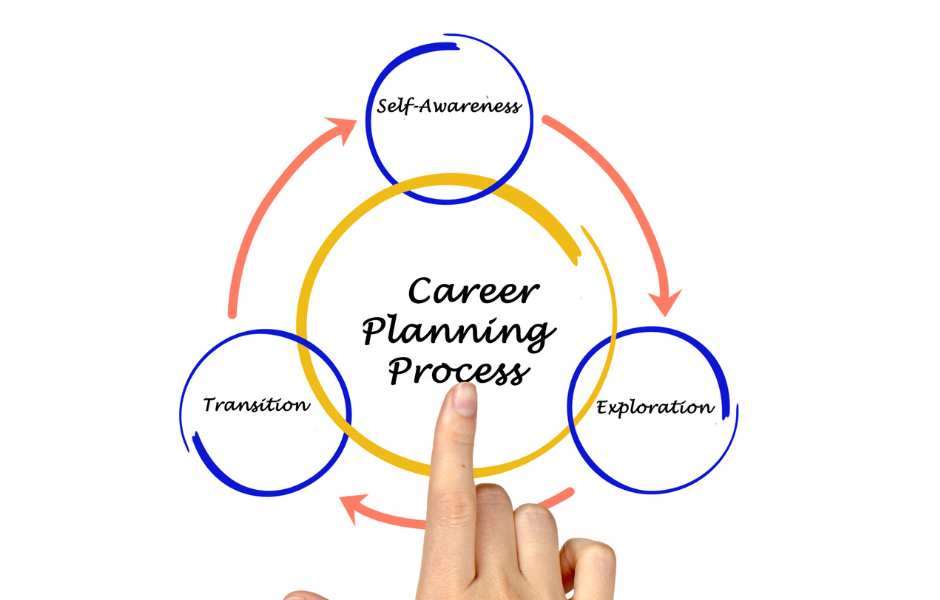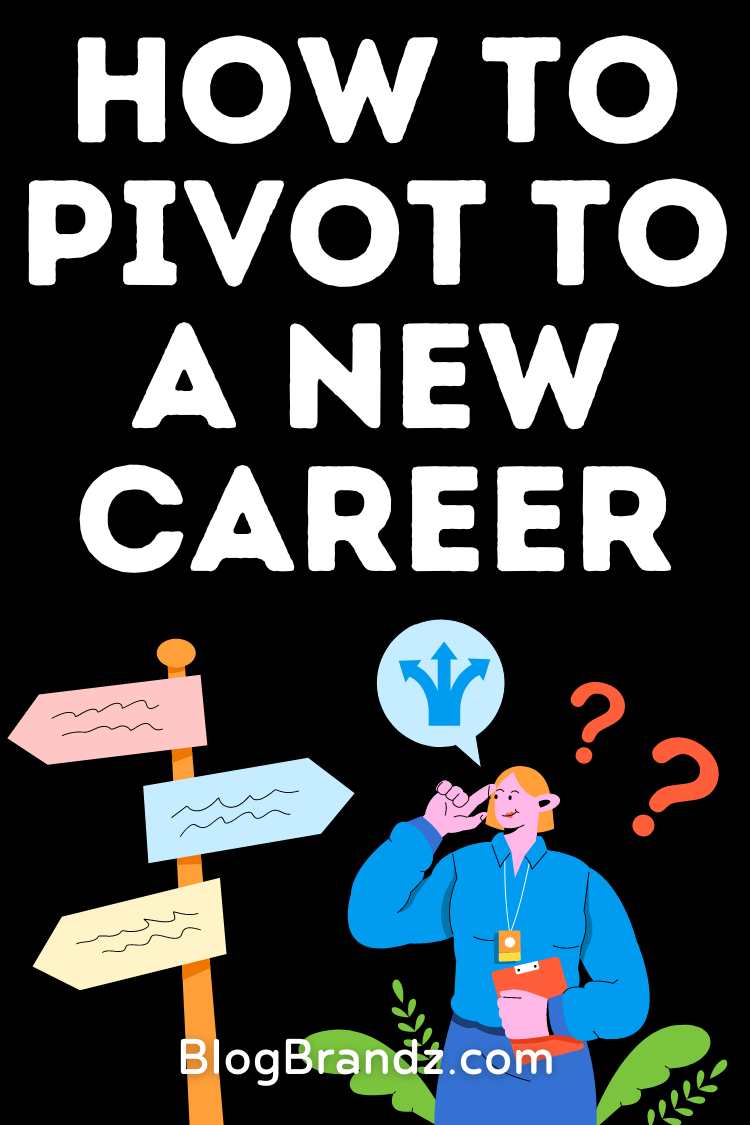Learn how to pivot careers successfully for a successful career transition by assessing your skills, researching new industries, and building a network.
Navigating a career transition can be both exciting and daunting. Whether you’re looking for a new challenge, seeking a better work-life balance, or pursuing a long-held passion, transitioning to a new career requires careful planning and strategic steps.
Contents
- What is a Career Transition?
- The Impact of AI on Career Transition Services
- What are the Reasons to Pivot Careers?
- Career Transition & Job Search Courses
- #1. How to Change Careers and Find the Job You Love
- #2. Career Change: 5 Key Skills To Change Your Career
- #3. Remote Work Revolution: How to Transition Your Career
- #4. Udemy IT Career Transition Course
- #6. Job Search, Career Development & Career Change Masterclass
- #7. The Career Design Lab: Change your Job, Change your Life
- #8. Adapting: Career Development Specialization
- #9. Essential Skills for Your Career Development
- #10. Elaine Welteroth Teaches Designing Your Career
- How To Pivot To a New Career
- How to Explain Your Career Transition
- How to Write Resumes for Career Transitions
- How to Write a Cover Letter for Career Transitions
- How to Use Your Linkedin Profile to Power a Career Transition
- What is a Career Transition Assistance Plan (CTAP)?
- Career Tips & Tools
What is a Career Transition?
A career transition refers to the process of moving from one job or field to another. It typically involves changing roles, industries, or career paths.
It can be prompted by several factors such as seeking new challenges, pursuing a passion, or adapting to changes in the job market.
Career transitions often require individuals to acquire new skills, network with professionals in their desired field, and update their resumes and online profiles to reflect their new career goals.
Successful career transitions result from careful planning, self-assessment, and a willingness to learn and adapt to new opportunities.
The Impact of AI on Career Transition Services
According to the WEF’s Future of Jobs Report 2023, artificial intelligence will replace 85 million jobs by 2025. With AI and automation leading to job displacement in many sectors, more individuals will seek support in navigating these changes and transitioning to new roles or industries.
As the impact of artificial intelligence (AI) continues to grow and reshape industries, the demand for career transition services will increase. Career transition coaching will be crucial in helping workers identify transferable skills, explore new career paths, and acquire the necessary skills for emerging roles.
A job and career transition coach can also provide emotional support and guidance during a challenging and uncertain time, making them invaluable resources in a rapidly evolving job market shaped by AI.
What are the Reasons to Pivot Careers?
Why do you want to make a career transition? Here are several reasons why someone might choose to make a career transition or pivot careers:
- Seeking New Challenges: Feeling stagnant or unfulfilled in your current role can prompt a desire for new challenges and opportunities for growth.
- Passion for a New Field: Discovering a passion for a different industry or role can motivate a career change to pursue something more personally fulfilling.
- Better Work-Life Balance: Some may pivot careers to better balance their professional and personal lives, seeking careers that offer more flexibility or less stress.
- Economic Factors: Changes in the economy or job market may necessitate a career pivot to secure stable employment or pursue higher-paying opportunities.
- Skills Misalignment: Recognizing that your current skills and interests are better suited to a different career path can lead to a desire to pivot careers.
- Personal Growth: A desire for personal development and self-improvement can drive a career change to explore new skills and experiences.
- Health Reasons: Health issues or a desire for a career that promotes well-being may lead to a pivot towards a more health-conscious industry or role.
- Job Insecurity: Concerns about job stability or dissatisfaction with the current job market may prompt a career pivot to a more stable or in-demand field.
- Lack of Advancement Opportunities: Limited opportunities for advancement or growth in your current role can be a motivating factor to pivot careers in search of better prospects.
- Entrepreneurial Spirit: A desire to start a business or work independently can lead to a career pivot to pursue freelancing, solopreneurship, or entrepreneurship opportunities.
Career Transition & Job Search Courses
#1. How to Change Careers and Find the Job You Love
In this course, you’ll explore new, fulfilling, and purpose-driven career opportunities to enhance success and happiness. Learn effective strategies to find a career you’ll love by defining your wants and needs for greater fulfillment and success.
Generate creative career ideas and filter them down to a realistic shortlist. Test and validate your most promising career options and develop criteria for your next job. Design a career transition plan and consider important factors if you’re thinking about self-employment.
#2. Career Change: 5 Key Skills To Change Your Career
In this course, you’ll discover five key skills to successfully change your career with insights from a career coach and former PwC consultant who navigated his career change.
Learn how to identify the right career path, understand the motivations behind your career change, and explore new career options while remaining in your current job.
Gain strategies to impress hiring managers, expand your network, and uncover hidden career opportunities. Develop your skills in researching career options, reworking your CV, acing interviews, and optimizing your LinkedIn profile.
Connect with successful individuals in your desired field and leverage professional groups to support your career transition.
#3. Remote Work Revolution: How to Transition Your Career
This course is designed for individuals from various professional backgrounds seeking to shift to remote work. You’ll learn how to craft a resume that appeals to remote-first companies, emphasizing skills and experiences relevant to the digital realm.
Learn about essential remote work tools like Slack, Loom, Asana, and Google Workspace, and best practices for asynchronous communication. Access an exclusive online support community and guidance on building an online network to support your remote career transition.
#4. Udemy IT Career Transition Course
This course helps individuals in the IT field explore new career paths and transition to the business side of organizations. You’ll gain clarity on your desired career path, develop a strategic career transition plan, and learn practical steps to execute your transformation effectively.
It will help you foster a growth mindset and embrace change as an opportunity for personal and professional development. Learn how to leverage your IT knowledge as a valuable asset in the business realm, adapt to new roles or industries, and enhance decision-making skills when faced with multiple career options.
#6. Job Search, Career Development & Career Change Masterclass
Unlock the secrets of career coaching for a successful job search, resume building, interviewing skills, LinkedIn networking, and achieving a fulfilling career in this Job Search, Career Development & Career Change Masterclass.
Manage the highs and lows of job searching with a winning mindset, building confidence while reducing stress. Identify the role that best fits your talents and personality for a successful career change.
Learn networking strategies to connect with any company you’re interested in. Adapt your skills and experience to land any role, regardless of your resume.
Gain an edge over the competition with a comprehensive playbook for interview preparation. Maximize your job offer with strategies to ensure you receive the best possible offer.
#7. The Career Design Lab: Change your Job, Change your Life
Discover the secret to transforming a job into a fulfilling career and true calling. Uncover the art of crafting a professional life that enriches your pockets and soul.
This immersive career planning course guides you in harnessing your strengths, values, skills, and beliefs as guiding stars to explore new career horizons.
Decode the roadmap to your next adventure, confidently choosing your path. Supercharge your job search with authentic strategies and tools to forge invaluable connections and uncover golden opportunities.
#8. Adapting: Career Development Specialization
Explore the art of self-directed personal change and its role in leadership development. Understand the complexities of stress, and its causes, and discover strategies to enhance your resilience.
Learn to tailor your career path to align with your values, interests, personality, and skills. Explore cultural intelligence to develop sensitivity and navigate the global workplace effectively.
#9. Essential Skills for Your Career Development
Gain invaluable tools for navigating your career path. Learn to create a roadmap and vision board to guide your journey, and confidently articulate your career vision.
Identify key champions, organizations, and platforms to enhance your network. Develop compelling communication skills to engage with these connections and foster collaborations. Learn to evaluate your strategy’s impact and adapt based on real-world results.
#10. Elaine Welteroth Teaches Designing Your Career
Award-winning journalist Elaine Welteroth, known for her impactful tenure at Teen Vogue, now brings her expertise to help you design your dream career. As a New York Times bestselling author, multimedia powerhouse, and judge on Project Runway, she knows what it takes to make dreams a reality.
Elaine will guide you in breaking free from your comfort zone and crafting a career that aligns with your core values, passions, and skills, creating a path as unique as you are.
Click here to join this MasterClass on Designing Your Career
How To Pivot To a New Career
Career transitions can be a significant but rewarding change. This career transition plan will help you pivot your career seamlessly:
#1. Do a Self-Assessment
Self-assessment is a crucial first step when pivoting to a new career. Here are some actionable career transition tips and examples to help you assess your skills, interests, and values:
- Skills Assessment:
List your technical skills (e.g., programming languages, design software, financial analysis) and soft skills (e.g., communication, leadership, problem-solving).
Consider taking skills assessment tests or quizzes online to better understand your strengths and areas for improvement.
Here are some scientific career assessments to help you learn your personality traits, clarify your career interests, and identify your strengths.
- TraitLab’s Free Personality Test
- Free CareerFitter Career Test
- Career Clarifier’s Online Career Test
Identify skills that are transferable to your desired career. For example, when making a career transition from marketing to data analysis, skills like data interpretation and storytelling can be valuable.
- Interests Assessment:
Reflect on activities or subjects that you enjoy and are passionate about. These can provide clues about potential career paths.
Explore new interests by volunteering, taking courses, or attending workshops in areas you’re curious about. This can help you discover new passions and career possibilities.
- Values Assessment:
Identify your core values, like work-life balance, social impact, creativity, or autonomy. Consider how your current or past roles align with these values. If there’s a mismatch, it may indicate a need for a career change.
Look for industries or roles that prioritize your values. For example, if the work-life balance is important to you, consider careers with flexible schedules or remote work options.
- Aligning Skills, Interests, and Values:
Create a Venn diagram or matrix to visualize the overlap between your skills, interests, and values. This can help you identify potential career paths that align with all three.
For example, if you’re skilled in project management, interested in environmental issues, and value sustainability, you might consider a career in sustainable project management or green technology.
- Seek Feedback:
Ask friends, family, and colleagues for input on your skills, interests, and values. They may offer valuable insights or perspectives you haven’t considered.
Consider working with a career transition coach or consultant who can provide professional guidance and help you clarify your career goals.
#2. Research Career Options
Once you better understand your skills, interests, and values, research potential career options that align with them. Researching career options is crucial for making an informed decision when pivoting to a new career.
Here are some actionable tips and examples:
- Utilize Online Resources:
Explore career websites such as LinkedIn, Indeed, Glassdoor, and CareerBuilder to search for job listings in your desired field.
Use industry-specific websites and forums to learn about trends, challenges, and opportunities. Read industry reports and publications to gain insights into its current state and future outlook.
- Attend Virtual Events and Webinars:
Participate in virtual career fairs, industry conferences, and webinars to learn from professionals in your desired field. Networking events can also provide valuable connections and insights into potential career paths.
- Informational Interviews:
Reach out to professionals in your target industry or role for informational interviews. Ask about their career paths, daily responsibilities, and advice for entering the field.
Informational interviews can help you gather firsthand insights and build a network of contacts in your desired industry.
- Evaluate Career Paths:
Consider the long-term prospects, growth potential, and work-life balance of each career path you’re considering.
Explore different industries and roles to understand their requirements, growth potential, and work culture. Look for roles that align with your skills, interests, and values, and offer opportunities for growth and advancement.
Researching potential career options to understand the industry, roles, and opportunities available. This knowledge will help you make a more informed decision when pivoting to a new career.
#3. Create a Career Vision Board
A career vision board can be a powerful tool to visualize your ideal career and stay motivated during your career pivot journey. Here’s how you can create one:
- Gather Your Materials:
Start by gathering materials such as a poster board, magazines, newspapers, markers, stickers, and any other decorations you’d like to use.
- Define Your Goals:
Before you start, take some time to define your career goals and aspirations. What do you want to achieve in your new career? What values and passions do you want to incorporate into your work?
- Find Inspiration:
Look for images, quotes, and words that resonate with your career goals and aspirations. These can come from magazines, online sources, or drawings and writings.
- Create Your Vision Board:
Begin by arranging your materials on the poster board in a way that feels inspiring and meaningful.
Use images, quotes, and words to represent your ideal career, including job roles, work environment, achievements, and personal growth.
Be creative and let your career vision board reflect your unique aspirations and desires for your career.
- Display Your Vision Board:
Once you’ve completed your career vision board, place it in a prominent place where you’ll see it daily, such as your workspace or bedroom.
Take a few moments each day to look at your vision board and visualize yourself achieving your career goals. This can help keep you motivated and focused on your career pivot journey.
- Review and Update Regularly:
Regularly review your career vision board to remind yourself of your career goals and aspirations. Update your vision board as your goals evolve or as you make progress in your career pivot journey.
#4. Skills Gap Analysis
According to the WEF’s Future of Jobs Report 2023, on average, 44 percent of an individual’s skill set is expected to change across all jobs.
The most in-demand skills will include analytical and creative thinking, technological literacy, curiosity and lifelong learning, resilience and flexibility, systems thinking, and AI and big data expertise.
Conducting a skills gap analysis is essential when pivoting to a new career. Here’s how you can do it:
- Research Your Target Role:
Start by researching the skills and qualifications required for your desired role. Look at job descriptions, industry reports, and professional organizations’ websites to identify key competencies.
- Assess Your Current Skills:
Make a list of your current skills and compare them to the skills required for your target role. This will help you identify any gaps that need to be addressed.
- Identify Skill Gaps:
Highlight the skills and qualifications you currently lack but are required for your desired role. These are your skill gaps.
Identify and highlight transferable skills from your current role that apply to your desired career. This can help you bridge the gap between industries.
- Determine Training Needs:
Based on your skills gap analysis, determine what additional education, training, or certifications you need to acquire the necessary skills for your target role.
- Create a Learning Plan:
Develop a learning plan outlining how you’ll acquire the necessary skills and qualifications. Set specific goals and timelines for completing each step of your learning journey.
- Embrace Micro-Reskilling:
Instead of focusing on complete career changes, consider micro-reskilling by acquiring small, targeted skills that can complement your current expertise and open up new opportunities.
Consider traditional and non-traditional education options, online courses, workshops, boot camps, or obtaining certifications related to your target field.
Platforms like Coursera and Udemy offer a vast collection of online courses and certifications in various industries to help you gain the required skills quickly and affordably.
By conducting a skills gap analysis and taking proactive steps to acquire the necessary skills and qualifications, you can position yourself for a successful career pivot.
#5. Build a Strong Network
Networking is a crucial step when pivoting to a new career. Here’s how you can effectively network to expand your opportunities:
- Online Networking:
Create a compelling LinkedIn profile highlighting your skills, experiences, and career goals. Join industry-specific groups and participate in discussions to connect with professionals in your desired field.
Use LinkedIn’s advanced search feature to find and connect with individuals who work in your target industry or role. Engage with industry influencers and thought leaders by commenting on their posts and sharing relevant content.
- Attend Industry Events:
Attend industry conferences, seminars, workshops, and networking events to meet professionals in your desired field.
Use these events to introduce yourself, exchange contact information, and learn about industry trends, best practices, and potential career opportunities.
Be prepared with a short elevator speech that highlights your background, career goals, and what you can offer to potential employers or collaborators.
- Join Online Communities:
Networking in online communities can lead to valuable connections and opportunities for collaboration. Participate in online forums, discussion groups, and communities related to your target industry or role.
Engage in discussions, ask questions, and share your insights to establish yourself as a valuable community. Seek out leadership roles in professional organizations or community groups. This can help you develop leadership skills and expand your network.
- Utilize Alumni Networks:
Leverage your university or college alumni network to connect with professionals who share your educational background. Attend alumni events or join online alumni groups to expand your network and explore potential career opportunities.
- Utilize Co-working Spaces:
Join a co-working space in your desired industry to immerse yourself in the environment and connect with professionals who can offer guidance and opportunities.
- Follow-Up and Stay Connected:
After networking events or meetings, follow up with a thank-you email or message to express your appreciation for the opportunity to connect.
Stay connected with your network by periodically checking in, sharing relevant updates, and offering support or assistance when needed.
By actively networking and building relationships in your desired industry, you can expand your opportunities and increase your chances of success when pivoting to a new career.
#6. Build Work Experience
Building work experience in your desired field is essential when pivoting to a new career. Here’s how you can gain practical experience:
- Internships:
Look for internships in your target industry or role, even if they are short-term or unpaid. Internships can provide valuable hands-on experience and help you build relevant skills.
Check with local companies, job boards, and career services offices for internship opportunities.
- Volunteer Work:
Consider volunteering for organizations or projects related to your desired career. This can help you gain experience, expand your network, and demonstrate your commitment to the field.
Look for volunteer opportunities that allow you to apply your skills and contribute meaningfully to the organization.
- Freelance Projects:
Take on freelance projects or side gigs in your target field. This can help you build skills and a work portfolio, gain experience, and test the waters before making a full career transition.
It will also help you demonstrate your abilities to potential employers or clients. Join freelance platforms to find freelance opportunities.
- Job Shadowing:
Explore job shadowing opportunities where you can observe professionals in your desired role. This can give you firsthand insight into the day-to-day responsibilities and challenges of the job.
Reach out to professionals in your network or organizations in your target industry to inquire about job shadowing opportunities.
By actively seeking opportunities to gain practical experience in your target field, you can enhance your skills, build your network, and increase your chances of successfully transitioning into your new career.
#7. Update Your Resume & Online Presence
Updating your resume and online presence is crucial when pivoting to a new career. Here’s how you can do it effectively:
- Update Your Resume:
Start by reviewing your current resume and identifying relevant skills, experiences, and accomplishments that align with your new career goals.
Tailor your resume to highlight these relevant skills and experiences, placing them prominently in your resume summary, work experience, and skills sections.
Use keywords and phrases from job descriptions in your new field to optimize your resume for applicant tracking systems (ATS) used by many employers.
- Highlight Transferable Skills:
Emphasize transferable skills relevant to your new career, such as leadership, communication, problem-solving, and project management skills.
Use specific examples from your past experiences to demonstrate how you’ve applied these skills in different contexts.
- Update Your LinkedIn Profile:
Update your LinkedIn profile to reflect your career pivot. Update your headline, summary, and work experience sections to highlight your new career goals and relevant experiences.
Use LinkedIn’s skills section to showcase skills relevant to your new career. Endorsements from colleagues and connections can help validate these skills.
Connect with professionals in your new field and join relevant LinkedIn groups to expand your network and stay updated on industry trends.
- Include Relevant Training & Certifications:
If you’ve completed any training, certifications, or courses relevant to your new career, include them in your resume and LinkedIn profile.
Highlight any relevant projects or assignments from these training programs to demonstrate your skills and knowledge in your new field.
- Update Your Online Portfolio:
If you have an online portfolio or personal website, update it to showcase relevant work samples, projects, and achievements related to your new career.
Include links to your portfolio on your resume and LinkedIn profile for easy access to your work.
- Seek Feedback:
Consult with a career transition coach, professionals in your new field, or mentors for feedback on your updated resume and LinkedIn profile. They can provide valuable insights and suggestions for improvement.
By updating your resume and online presence to align with your new career goals, you can effectively communicate your qualifications and increase your chances of success in your career pivot.
#8. Create a Personal Brand
Creating a personal brand can be instrumental in standing out during a career pivot. Here’s how you can develop a strong personal brand:
- Define Your Brand:
Identify your unique skills, strengths, values, and passions. What sets you apart from others in your field? Determine how you want to be perceived by others in your industry. What do you want to be known for?
- Create a Personal Brand Statement:
Craft a concise and compelling personal brand statement that communicates who you are, what you do, and the value you offer.
Your personal brand statement should resonate with your target audience and differentiate you from others in your field.
- Build a Professional Online Presence:
Create a professional-looking website or blog where you can showcase your expertise, share your insights and experiences, and engage with your audience.
Use social media platforms like LinkedIn, Twitter, and Instagram to share relevant content, connect with industry professionals, and build your online presence.
- Share Valuable Content:
Create and share valuable content related to your industry or niche. This could include articles, blog posts, videos, podcasts, or infographics. Position yourself as a thought leader by sharing your expertise and insights on relevant topics.
- Engage with Your Audience:
Engage with your audience on social media by responding to comments, answering questions, and participating in discussions.
Build relationships with influencers and other professionals by sharing their content and engaging with their posts.
- Consistency is Key:
Be consistent in your messaging, branding, and content. This helps reinforce your personal brand and makes you more memorable to your audience.
Regularly update your website and social media profiles to reflect your latest achievements and projects.
- Seek Feedback and Adjust:
Ask for feedback from a career transition specialist, your audience, peers, and mentors to see how people see your personal brand. Use it to make adjustments and improvements to your brand over time.
By developing a strong personal brand, you can differentiate yourself from others in your field, establish yourself as an authority in your industry, and attract new opportunities during your career pivot.
#9. Seek Mentorship & Coaching
Seeking support, mentorship, and coaching is crucial during a career change. Here’s how you can find and benefit from mentors, career counselors, or coaches:
- Opt for Career Transition Coaching:
A career transition coach provides personalized assessments and in-depth career transition assistance to help clients gain clarity on their passions, strengths, and ideal career paths.
Career transition coaches provide work with clients to craft step-by-step plans for navigating their career paths, ensuring every move is purposeful and effective.
Additionally, career transition specialists equip clients with valuable tools and techniques to excel in interviews, networking, and seizing new opportunities, serving as a compass for successful career shifts or professional growth.
- Identify Potential Mentors:
Look for successful individuals in your desired field willing to mentor others. Consider professionals within and outside your current network who can offer valuable insights and guidance.
- Reach Out & Build Relationships:
Contact potential mentors through email, LinkedIn, or professional networking events. Be clear about your goals and what you hope to gain from the mentorship. Explain why you believe they would be a valuable mentor for you.
- Be Open to Different Perspectives:
Consider mentors who may offer fresh perspectives, even if they are outside your industry or network. Different perspectives can help you think creatively and approach your career pivot from new angles.
- Be Proactive and Respectful:
Take the initiative to schedule meetings or calls with your mentor. Respect their time and expertise by coming prepared with specific questions and topics for discussion.
- Seek Feedback and Guidance:
Regularly seek feedback from your mentor on your career goals and progress. Use their guidance to make informed decisions and navigate challenges during your career pivot.
- Express Gratitude:
Show appreciation for your mentor’s time and advice. A simple thank-you can go a long way in maintaining a positive and fruitful mentoring relationship.
By seeking support and mentorship from experienced professionals, you can gain valuable insights, guidance, and support as you navigate your career pivot.
How to Explain Your Career Transition
Explaining your career transition to potential employers or colleagues involves communicating your reasons, highlighting your relevant skills and experiences, and showcasing your readiness for the new role or industry.
Here are some tips to do it effectively:
- Be Honest & Transparent:
Be open about your reasons for making the career transition. Whether you’re seeking new challenges, pursuing a passion, or looking for a better work-life balance, honesty can help others understand your motivations.
- Highlight Relevant Skills & Experiences:
Emphasize the transferable skills and experiences from your previous career that are relevant to your new path. This can help demonstrate your value and suitability for the new role or industry.
- Showcase Your Learning & Growth:
Discuss any steps you’ve taken to prepare for the transition, such as completing courses, gaining certifications, or participating in relevant projects. This shows your commitment to learning and adapting to new challenges.
- Connect Past Experiences to Future Goals:
Explain how your past experiences have led you to pursue this new career path and how they will help you succeed in your new role. This can help others see the logical progression of your career transition.
- Be Positive and Confident:
Approach the explanation of your career transition with a positive attitude and confidence in your decision. This can help others see your transition in a positive light and feel confident in your abilities.
- Practice Your Explanation:
Before discussing your career transition with others, practice your explanation to ensure it is clear and concise, and effectively communicates your reasons and goals.
- Seek Feedback and Support:
Consider seeking feedback from mentors, career transition coaches, or trusted colleagues on how to best explain your career transition. Their insights can help you refine your explanation and approach.
How to Write Resumes for Career Transitions
Writing a resume for a career transition involves highlighting transferable skills, relevant experiences, and accomplishments that demonstrate your suitability for the new role or industry.
Here’s a basic structure you can follow:
- Header:
Include your name, contact information, and a professional summary or objective statement that highlights your career transition and the value you bring to the new role.
- Summary of Qualifications:
Summarize your key skills, experiences, and accomplishments that are relevant to the new role. Highlight any transferable skills or experiences that demonstrate your ability to succeed in the new field.
- Skills:
List relevant skills transferable to the new role, such as leadership, communication, project management, and technical skills. Include hard skills (e.g., software proficiency) and soft skills (e.g., communication skills).
- Professional Experience:
Include your work experience, focusing on roles and accomplishments most relevant to the new career.
Emphasize transferable skills and experiences that demonstrate your ability to succeed in the new role. Use quantifiable achievements and results to showcase your impact in previous roles.
- Education:
List your educational background, including degrees, certifications, and relevant coursework. Highlight any educational experiences relevant to the new career, such as continuing education or relevant certifications.
- Additional Sections:
Consider including additional sections that highlight relevant experiences or accomplishments, such as volunteer work, professional associations, or relevant projects.
- Formatting:
Use a clean, professional format with clear headings and bullet points to make your resume easy to read. Keep your resume concise and focused, limiting it to one or two pages.
- Tailor Your Resume:
Customize your resume for each job application, highlighting the most relevant skills and experiences for the specific role. Use keywords from the job description to optimize your resume for applicant tracking systems (ATS).
By highlighting transferable skills, relevant experiences, and accomplishments, you can create a compelling resume that showcases your qualifications and suitability for a career transition.
- Hire a professional resume writer:
Professional resume writers offer several advantages over a DIY approach, including industry expertise, tailored content, and awareness of current hiring trends.
Career.io’s resume writing services provide professionally crafted resumes, cover letters, and LinkedIn profiles highlighting your unique skills and experience, giving you a competitive edge in the job market.
How to Write a Cover Letter for Career Transitions
Writing a cover letter for a career transition requires highlighting your transferable skills, showcasing your passion for the new role or industry, and explaining how your past experiences make you a strong candidate.
Here’s a basic structure you can follow:
- Introduction:
Start by introducing yourself and explaining the purpose of your letter. Mention the position you are applying for and where you found the job listing.
- Transition Explanation:
Briefly explain your career transition and why you are interested in this new role or industry. Highlight any relevant experiences or skills that make you a suitable candidate.
- Transferable Skills:
Identify and emphasize previous career skills transferable to the new role. Provide specific examples of how you have used these skills to achieve results.
- Passion and Fit:
Demonstrate your passion for the new role or industry and explain your excitement about the opportunity. Explain how your values and career goals align with those of the company.
- Closing:
Express your enthusiasm for the opportunity to discuss your application further. Thank the employer for considering your application and provide your contact information for follow-up.
- Formatting:
Use a professional format with a clear and concise writing style. Keep the cover letter to one page and use a standard font and font size.
Customize your cover letter for each job application, highlighting the most relevant skills and experiences for the specific role.
How to Use Your Linkedin Profile to Power a Career Transition
Using your LinkedIn profile can be a powerful tool for facilitating a career transition. Here are some tips on how to leverage your LinkedIn profile:
- Update Your Profile:
Ensure your LinkedIn profile is up to date with your current job, skills, and experiences. Use a professional photo and headline that reflects your career goals.
- Optimize Your Summary:
Craft a compelling LinkedIn summary highlighting your transferable skills, relevant experiences, and career goals. Use keywords related to your desired role or industry.
- Highlight Relevant Experience:
Showcase your most relevant experiences and accomplishments demonstrating your ability to succeed in your new career path. Use bullet points to highlight key achievements.
- Skills and Endorsements:
List your skills, including both technical and soft skills relevant to your new career. Request endorsements from colleagues and connections to validate your skills.
- Join Relevant Groups:
Join LinkedIn groups related to your target industry or role. Engage in discussions, share relevant content, and connect with professionals in your desired field.
- Network:
Use LinkedIn to expand your professional network. Connect with professionals in your target industry or role and engage with their content to build relationships.
- Follow Companies:
Follow companies in your desired industry to stay updated on their latest news, job postings, and industry trends.
- Use the Job Search Feature:
Utilize LinkedIn’s job search feature to find relevant job postings in your new career field. Save job searches and set up alerts to receive notifications for new job postings.
- Seek Recommendations:
Request recommendations from colleagues, supervisors, or clients who can speak to your skills and abilities relevant to your new career path.
- Engage with Content:
Like, comment, and share relevant content related to your new career path. This can help you establish yourself as a knowledgeable professional in your desired field.
By optimizing your LinkedIn profile and actively engaging with the platform, you can effectively use LinkedIn to power your career transition and connect with new opportunities in your desired field.
What is a Career Transition Assistance Plan (CTAP)?
The Career Transition Assistance Plan (CTAP) is an intra-agency program designed to support federal employees who are displaced or deemed surplus, assisting them in finding new job opportunities within their agency.
Career transition programs like CTAP provide affected employees with support and resources to help them transition to new employment opportunities.
This assistance may include career counseling, skills assessment, resume writing assistance, job search workshops, networking opportunities, and access to job placement services.
As a career transition assistance program, CTAP aims to mitigate the impact of job loss on affected employees by helping them develop the skills, confidence, and resources needed to successfully transition to new career opportunities.
A career transition requires courage and perseverance as career pivots take time and effort, regular assessments, and adjustments. Use the career transition advice above to stay open to new opportunities and be flexible in your approach.
Stay motivated and continue to pursue your goals, even if you encounter setbacks. With careful career planning and a clear vision, you can successfully transition into a new and fulfilling career.
Career Tips & Tools
- Build Your Resume: Free Resume Builder Tools & Templates
- How Personality Tests Can Help You Unlock Your Potential
- What Career Is Right for Me? How To Choose a Career
- ChatGPT Prompts for Resume/CV Writing
- Can I Manifest my Dream Job by Writing my Ideal Job?
- 27 Career Goal-Setting Steps to Land Your Dream Job
- 21 Best Occupations for the Most Meaningful Careers
- 25 Professional Skills for Success in the Workplace
- 15 AI Side Hustles to Make Money on the Side
- Top-Rated Coursera Courses Of 2024
- 7 Steps for Successfully Starting a New Journey in Life
© 2024, Priya Florence Shah. All rights reserved.
Priya Florence Shah is a bestselling author and an award-winning blogger. Check out Devi2Diva, her book on emotional self-care for women. In her spare time, Priya writes science-fiction novels and poetry and chills with her two-legged and four-legged kids.
Discover more from Business & Branding Tips
Subscribe to get the latest posts to your email.
























